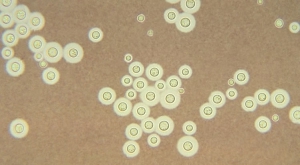We are very happy to announce David M. Beyer, Professor of Mushrooms, to our platform. To start, David briefly explains about his background and involvement in the mushroom industry.
For almost 45 years I have been involved in the mushroom industry, first and always as a student of mushroom science and then as a commercial mushroom grower.
I worked 12 years growing mushrooms at the largest mushroom company in Canada with a tray farm, 3 shelf farms and a Dutch-style bulk tunnel farm. As Director of Growing, I provided technical assistance and training to the growers at all 5 farms.
For the past 34 years I have worked at Penn State as the director of the mushroom extension program for the North American commercial mushroom industry. My previous commercial growing experience provides practical insight into the development and organization of my educational programs that address the changing needs of the industry.
My research program involves all aspects of mushroom growing from composting, compost nutrition for the mushroom, disease management (IPM), and cultural factors affecting mushroom yield, size, and quality. I have developed and conducted several customized grower educational programs for mushroom farms and suppliers.
For almost 45 years I have been involved in the mushroom industry, first and always as a student of mushroom science and then as a commercial mushroom grower.
I worked 12 years growing mushrooms at the largest mushroom company in Canada with a tray farm, 3 shelf farms and a Dutch-style bulk tunnel farm. As Director of Growing, I provided technical assistance and training to the growers at all 5 farms.
For the past 34 years I have worked at Penn State as the director of the mushroom extension program for the North American commercial mushroom industry. My previous commercial growing experience provides practical insight into the development and organization of my educational programs that address the changing needs of the industry.
My research program involves all aspects of mushroom growing from composting, compost nutrition for the mushroom, disease management (IPM), and cultural factors affecting mushroom yield, size, and quality. I have developed and conducted several customized grower educational programs for mushroom farms and suppliers.
Fungi That 'Eat' Radiation Are Growing on the Walls of Chernobyl's Ruined Nuclear Reactor
Back in 1991, scientists were amazed when they made the discovery...
In the eerie environment inside the abandoned Chernobyl Nuclear Power Plant, researchers remotely piloting robots spotted pitch black fungi growing on the walls of the decimated No. 4 nuclear reactor and even apparently breaking down radioactive graphite from the core itself. What's more, the fungi seemed to be growing towards sources of radiation, as if the microbes were attracted to them!
More than a decade later, University of Saskatchewan Professor Ekaterina Dadachova (then at the Albert Einstein College of Medicine in New York) and her colleagues acquired some of the fungi and found that they grew faster in the presence of radiation compared to other fungi. The three species tested, Cladosporium sphaerospermum, Cryptococcus neoformans and Wangiella dermatitidis, all had large amounts of the pigment melanin, which is found – among many places – in the skin of humans. People with a darker skin tone have much more of it. Melanin is known to absorb light and dissipate ultraviolet radiation, but in the fungi, it seemed to also be absorbing radiation and converting it into chemical energy for growth, perhaps in a similar fashion to how plants utilize the green pigment chlorophyll to attain energy from photosynthesis.
Back in 1991, scientists were amazed when they made the discovery...
In the eerie environment inside the abandoned Chernobyl Nuclear Power Plant, researchers remotely piloting robots spotted pitch black fungi growing on the walls of the decimated No. 4 nuclear reactor and even apparently breaking down radioactive graphite from the core itself. What's more, the fungi seemed to be growing towards sources of radiation, as if the microbes were attracted to them!
More than a decade later, University of Saskatchewan Professor Ekaterina Dadachova (then at the Albert Einstein College of Medicine in New York) and her colleagues acquired some of the fungi and found that they grew faster in the presence of radiation compared to other fungi. The three species tested, Cladosporium sphaerospermum, Cryptococcus neoformans and Wangiella dermatitidis, all had large amounts of the pigment melanin, which is found – among many places – in the skin of humans. People with a darker skin tone have much more of it. Melanin is known to absorb light and dissipate ultraviolet radiation, but in the fungi, it seemed to also be absorbing radiation and converting it into chemical energy for growth, perhaps in a similar fashion to how plants utilize the green pigment chlorophyll to attain energy from photosynthesis.
Click here for the full article
Source: RealClear Science By Ross Pomeroy - RCP Staff
NASA building homes made of fungi for Moon, Mars
Instead of habitats made of metal and glass, NASA is exploring technologies that could grow structures out of fungi to become our future homes in the stars, and perhaps lead to more sustainable ways of living on Earth as well.
Creating a livable home for future astronauts means doing more than growing a roof to go over their heads.
Astronauts will need to have all their basic needs met, just like on Earth, and face the additional challenges of living in a harsh environment on a distant world, the US space agency said in a statement.
Keeping that in mind, the myco-architecture project out of NASA’s Ames Research Center in California is prototyping technologies that could “grow” habitats on the Moon, Mars and beyond out of life – specifically, fungi and the unseen underground threads that make up the main part of the fungus, known as mycelia.
“Right now, traditional habitat designs for Mars are like a turtle – carrying our homes with us on our backs – a reliable plan, but with huge energy costs,” said Lynn Rothschild, the principal investigator on the early-stage project.
“Instead, we can harness mycelia (vegetative part of a fungus) to grow these habitats ourselves when we get there”.
Click here for the full article

























